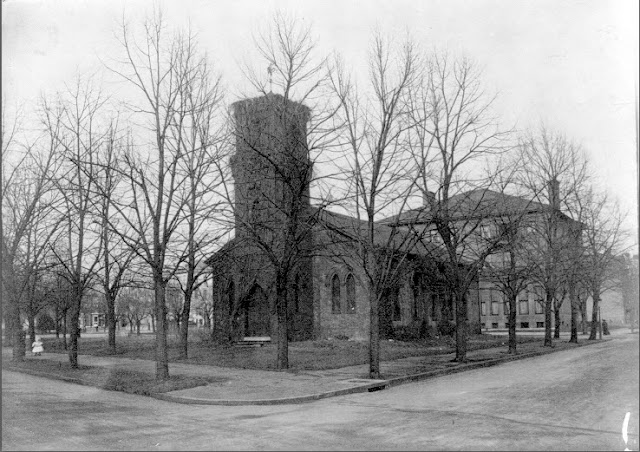The Story of St. Thomas Church: A Rise From the Ashes
The story of St. Thomas church at 1772 Church Street, NW began in 1886 when Reverend John Abel Aspinwall moved to Washington, DC. Aspinwall was the son of William Aspinwall, president of the Pacific Mail Steamship Company who had built the Panama Railroad across Panama. Due to poor health, John Aspinwall resigned as the rector of a church in Bay Ridge, Long Island, where he had been serving as rector for 21 years. After a three-year rest, and perhaps in search of another wealthy congregation, Aspinwall came to Washington, purchasing a mansion at 17 Dupont Circle. Upon his arrival, he became active in the formation of St. Thomas Parish and served as its first rector.
The parish’s first congregation began meeting in 1890 with a mere handful of people, worshipping in the abandoned Holy Cross Episcopal Church on Dupont Circle (now the site of the Sulgrave Club today at 1801 Massachusetts Avenue). That parish had closed due to financial troubles a few years before (most of the wealthy Dupont residents were Presbyterian) and the church was vacant.
 |
| Holy Cross Episcopal Church on Dupont Circle. Library of Congress |
In 1892, a parish hall, designed by architect T. F. Schneider (most noted for his Cairo Hotel building on Q Street) was built for the congregation on Church Street (then Monroe Street). The following year, Philadelphia architect Theophilus Chandler, who had just finished designing Levi Leiter’s mansion on Dupont Circle, was contracted to design a large Gothic-style church on the corner of 18th and Church Streets. The corner stone was laid in 1894 and construction was completed in 1899. Reverend Aspinwall resigned as the church’s rector in 1902, again due to poor health. Rev. C. Ernest Smith followed as the second rector. Aspinwall went on to earn a doctor of divinity from Virginia Theological Seminary in 1912, but died the following year at the age of 74 in his home on Dupont Circle. His funeral was held at St. Thomas.
The church also served as a community hall throughout its existence. In 1912, one of Washington’s two survivors of the Titanic, Col. Archibald Gracie, captivated fellow St. Thomas parishioners with his experiences on the sinking ship. After having survived one of the greatest tragedies of the 20th century, Col. Gracie would die within that same year from the stress he suffered from the disaster.
 |
| St. Thomas church. Library of Congress |
Over the years, the church was attended by Franklin and Eleanor Roosevelt, Harry S. Truman, and Edith Wilson (formerly Edith Galt). Franklin Roosevelt, while living on N Street and serving as Assistant Secretary of the Navy, was an active member of the parish and was elected to the church’s vestry in 1918. Roosevelt returned to the church and attended services the day after his inauguration in 1933. Hundreds of people lined up at the front entrance hoping to get into the 11 a.m. service to get a glimpse of the president. While president, Roosevelt continued to serve as an honorary senior warden of the church.
 |
| Franklin Roosevelt, Eleanor, and the President's mother arriving for a service on Christmas Day 1934. Library of Congress. |
After her husband's death, Eleanor Roosevelt kept her connection to St. Thomas. In 1956, she gave the first talk given by a lay person at the evening service, where she spoke about her work with the United Nations and human rights.
 |
| Interior of the original St. Thomas church |
 |
| Ruins of St. Thomas after the fire. |
Immediately after the fire, the vestry began the Phoenix Rising Project to consider its options and set a new direction for the parish. Options considered the time were rebuilding, merging with another parish, selling the property and moving elsewhere, or building a new, multi-use complex. The vestry ultimately voted to remain in the same location. As a result, the area once occupied by the church building, while still owned by the church was maintained and used as a small park and a contemplative area for public use. Over the years, the park became a neighborhood treasure and a much appreciated small bit of open space in the densely already built up area The T. F. Schneider-designed parsonage, which had survived the fire, continued to be used for the church's services and community functions.
 |
| Remaining rear walls and altar area of the church. |
In 2015, the vestry changed course and decided to build a new church on the site of the original, selling off part of its land, including the parsonage and cloister entrance, to finance the construction. Developer CAS Reigler and architects Hickcock-Cole were contracted for the project. The project met with much community opposition, with concerns over the new building's height and compatibility with the neighborhood, increased traffic, and the loss of the park. Ultimately, the project received approvals of the Historic Preservation Review Board and the Bureau of Zoning Adjustments.
Although a modern building was planned the site, the project was mindful of the history of the original church building and care was given to the original architectural features that remained. Evergreene Architectual Arts was contracted to measure each remaining stone and their condition, and a master plan of all stones was drawn showing all of the original joints, layouts and conditions. Many of the salvaged elements were then integrated into the design of the church with new uses.
The project, completed in 2019 and rising to a height of 65 feet, is comprised of three distinct sections, including the Church Street facade of the original parish hall with two added floors, with the existing Cloister entrance leading to a new block of apartments, and the new church along 18th Street. The church opened in April of 2019, celebrating its first service on Easter Sunday in the new building.
 |
| The new St. Thomas Church. Image: Hickcock-Cole |




Comments
Post a Comment